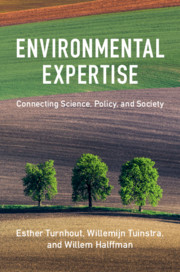Refine listing
Actions for selected content:
2285 results in Ebooks in ecology and environment
Notes on Units
-
- Book:
- There Is No Planet B
- Published online:
- 23 January 2019
- Print publication:
- 28 February 2019, pp 242-244
-
- Chapter
- Export citation
EndNotes
-
- Book:
- There Is No Planet B
- Published online:
- 23 January 2019
- Print publication:
- 28 February 2019, pp 245-276
-
- Chapter
- Export citation
5 - Growth, Money and Metrics
-
- Book:
- There Is No Planet B
- Published online:
- 23 January 2019
- Print publication:
- 28 February 2019, pp 119-148
-
- Chapter
- Export citation
9 - Conclusion: Thinking Skills for Today’s World
-
- Book:
- There Is No Planet B
- Published online:
- 23 January 2019
- Print publication:
- 28 February 2019, pp 185-194
-
- Chapter
- Export citation
2 - More on Climate and Environment
-
- Book:
- There Is No Planet B
- Published online:
- 23 January 2019
- Print publication:
- 28 February 2019, pp 51-58
-
- Chapter
- Export citation
Acknowledgements
-
- Book:
- There Is No Planet B
- Published online:
- 23 January 2019
- Print publication:
- 28 February 2019, pp xiii-xiv
-
- Chapter
- Export citation
Appendix: Climate Change Basics
-
- Book:
- There Is No Planet B
- Published online:
- 23 January 2019
- Print publication:
- 28 February 2019, pp 200-211
-
- Chapter
- Export citation
Reviews
-
- Book:
- There Is No Planet B
- Published online:
- 23 January 2019
- Print publication:
- 28 February 2019, pp ii-ii
-
- Chapter
- Export citation
1 - Food
-
- Book:
- There Is No Planet B
- Published online:
- 23 January 2019
- Print publication:
- 28 February 2019, pp 11-50
-
- Chapter
- Export citation
Alphabetical Quick Tour
-
- Book:
- There Is No Planet B
- Published online:
- 23 January 2019
- Print publication:
- 28 February 2019, pp 212-241
-
- Chapter
- Export citation
8 - Values, Truth and Trust
-
- Book:
- There Is No Planet B
- Published online:
- 23 January 2019
- Print publication:
- 28 February 2019, pp 169-184
-
- Chapter
- Export citation
Copyright page
-
- Book:
- There Is No Planet B
- Published online:
- 23 January 2019
- Print publication:
- 28 February 2019, pp iv-iv
-
- Chapter
- Export citation
Additional material
-
- Book:
- There Is No Planet B
- Published online:
- 23 January 2019
- Print publication:
- 28 February 2019, pp v-v
-
- Chapter
- Export citation
Index
-
- Book:
- There Is No Planet B
- Published online:
- 23 January 2019
- Print publication:
- 28 February 2019, pp 277-288
-
- Chapter
- Export citation
Contents
-
- Book:
- There Is No Planet B
- Published online:
- 23 January 2019
- Print publication:
- 28 February 2019, pp vii-xii
-
- Chapter
- Export citation

Environmental Expertise
- Connecting Science, Policy and Society
-
- Published online:
- 22 February 2019
- Print publication:
- 21 February 2019
Case J - Groupthink and Whistle Blowers in CO2 Capture and Storage
-
-
- Book:
- Environmental Expertise
- Published online:
- 22 February 2019
- Print publication:
- 21 February 2019, pp 234-246
-
- Chapter
- Export citation
7 - Interdisciplinarity and the Challenge of Knowledge Integration
-
-
- Book:
- Environmental Expertise
- Published online:
- 22 February 2019
- Print publication:
- 21 February 2019, pp 152-164
-
- Chapter
- Export citation
12 - Stomatal Conductance
-
- Book:
- Climate Change and Terrestrial Ecosystem Modeling
- Published online:
- 08 February 2019
- Print publication:
- 21 February 2019, pp 189-212
-
- Chapter
- Export citation
Contributors
-
- Book:
- Environmental Expertise
- Published online:
- 22 February 2019
- Print publication:
- 21 February 2019, pp ix-x
-
- Chapter
- Export citation
